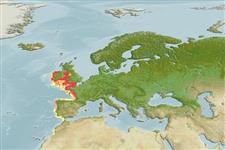Klassifizierung / Names
Namen | Synonyme | Catalog of Fishes (gen., sp.) | ITIS | CoL | WoRMS | Cloffa
Elasmobranchii (Haie und Rochen) (sharks and rays) >
Rajiformes (Skates and rays) >
Rajidae (Skates)
Etymology: Raja: Latin, raja, -ae = a sting ray (Raja sp.) (Ref. 45335).
Lebensraum / Klimazone / Range
Ökologie
; seewasser demersal; tiefenbereich ? - 100 m (Ref. 4426). Temperate, preferred 13°C (Ref. 107945); 55°N - 24°N, 16°W - 1°W
Eastern Atlantic: southwestern England and Ireland to Rio de Oro in Western Sahara; absent from the North Sea and the Mediterranean.
Length at first maturity / Size / Gewicht / Alter
Maturity: Lm 74.0, range 73 - ? cm
Max length : 80.0 cm TL Männchen/unbestimmt; (Ref. 41333); 86.0 cm TL (female); max. veröff. Gewicht: 4.5 kg (Ref. 4699)
Rückenflossenstacheln (insgesamt): 0; Afterflossenstacheln 0; Afterflossenweichstrahlen: 0. Eyes conspicuously small; dorsal fins close-set, no thorns between; upper surface predominantly spinulose, underside almost smooth in young, but head and centre of disc prickly in larger specimens; orbital thorns separate, a regular row of about 50 thorns from nape to first dorsal fin; upper surface greyish, olive to light brown with light blotches and long bands, underside white (Ref. 3167).
Found on sandy bottoms, from inshore waters to about 100 m in tidal areas (Ref. 3167). Feed on fishes (Ref. 3167). Oviparous. Distinct pairing with embrace. Young may tend to follow large objects, such as their mother (Ref. 205). Eggs are oblong capsules with stiff pointed horns at the corners deposited in sandy or muddy flats (Ref. 205). Egg capsules are 6.6-10.0 cm long and 4.1-6.3 cm wide (Ref. 41250). About 54-61 eggs are laid by an individual in a year (Ref. 41250).
Oviparous (Ref. 3167). Paired eggs are laid. Embryos feed solely on yolk (Ref. 50449). Distinct pairing with embrace. Young may tend to follow large objects, such as their mother (Ref. 205).
McEachran, J.D. and K.A. Dunn, 1998. Phylogenetic analysis of skates, a morphologically conservative clade of elasmobranchs (Chondrichthyes: Rajidae). Copeia 1998(2):271-290. (Ref. 27314)
IUCN Rote Liste Status (Ref. 115185)
CITES (Ref. 94142)
Not Evaluated
Bedrohung für Menschen
Harmless
Nutzung durch Menschen
Fischereien: weniger kommerziell; Sportfisch: ja
Mehr Information
ReferenzenAquakulturAquakultur ProfilZuchtlinienGenetikAllel-HäufigkeitenVererbbarkeitKrankheitenVerarbeitungMass conversion
Tools
Zusatzinformationen
Download XML
Internet Quellen
Estimates of some properties based on models
Phylogenetic diversity index (Ref.
82805): PD
50 = 0.5000 [Uniqueness, from 0.5 = low to 2.0 = high].
Bayesian length-weight: a=0.00457 (0.00276 - 0.00758), b=3.26 (3.12 - 3.40), in cm Total Length, based on LWR estimates for this species & Genus-body shape (Ref.
93245).
Trophic Level (Ref.
69278): 3.9 ±0.2 se; Based on diet studies.
Widerstandsfähigkeit (Ref.
69278): niedrig, Verdopplung der Population dauert 4,5 - 14 Jahre. (Fec= 54-61).
Verwundbarkeit (Ref.
59153): Moderate to high vulnerability (54 of 100) .
